Stock Market More Retracement Expected
Stock-Markets / Stock Markets 2015 Jan 26, 2015 - 10:28 AM GMTBy: Andre_Gratian
 Current Position of the Market
Current Position of the Market
SPX: Long-term trend - Bull Market
Intermediate trend - Is the 7-yr cycle sketching an intermediate top?
Analysis of the short-term trend is done on a daily basis with the help of hourly charts. It is an important adjunct to the analysis of daily and weekly charts which discusses the course of longer market trends.
MORE RETRACEMENT EXPECTED
Market Overview
During most of last week, SPX tacked on another 60+ points to the rally that started on 1/15, reaching the former short-term peak of 2064 on Thursday. Most of Friday's activity was spent in extensive profit-taking before sellers overcame the buyers, sending the index 11 points lower by the close.
Certainly, after a 76-point rally, SPX deserves to consolidate before continuing its uptrend - if that is what it intends to do. But by closing practically on its low of the day, it suggests that the correction is not over and that lower prices can be expected early next week. This is also borne out by the amount of distribution that occurred on Friday, and which has the potential of sending the index a good deal lower.
The cause of Friday's decline was concern over the Greek election which will take place on Sunday. Should the leftist candidate win (as is widely expected), it could accelerate the selling to the point where SPX will find it difficult to regain its short-term upside momentum. This, in turn, could result in a bearish January barometer which would have some implication for the market's performance during 2015.
Momentum: In spite of the rally, the weekly MACD moved a little lower while the daily MACD barely managed to make a bullish cross, but remained negative.
The weekly SRSI also continued to move lower. The daily moved to 100% on Thursday and started to correct on Friday.
Breadth: In spite of the market strength, the McClellan Oscillator only managed to close the week with a reading of 16.88 (on a scale of -100 to +100).
Structure: We will need more data to know whether or not primary wave III has come to an end.
Accumulation/distribution: On Friday, SPX created a fairly significant short-term distribution pattern, while the long-term formation continues to grow more and more impressive by the week. It will be confirmed as a distribution area if SPX moves decisively below 1972.
XIV: Continues to show relative weakness to the SPX on an intermediate basis.
Cycles: The 7-year cycle appears to be slowly gaining a foothold.
Chart Analysis
We start with the weekly SPX (chart courtesy of QCharts, including others below) with the McClellan Summation Index (courtesy of StockCharts.com) posted underneath it.

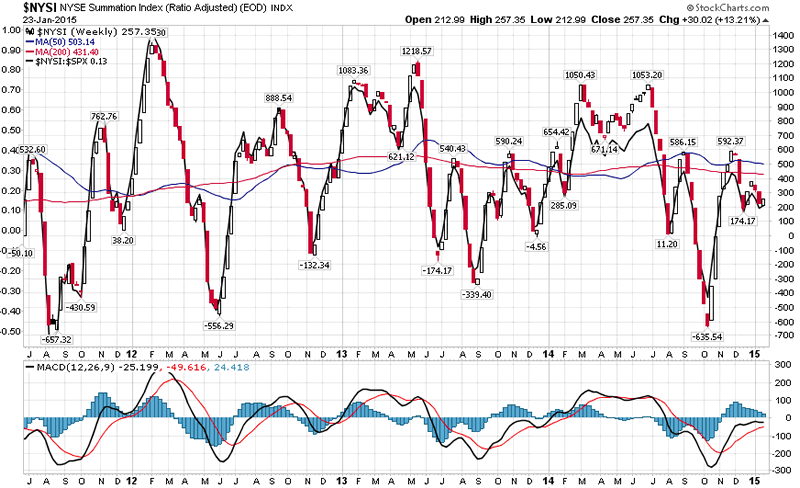
The weekly SPX has now gone three weeks without attempting to make a new high. During this time, it made a couple of unsuccessful attempts at moving below its 30-wk MA. If it tries again, it could succeed. You can see that this has served as a fexible trend line for nearly three years. The few times that it was breached, the index came roaring back above it right away. If it is broken decisively over the next few weeks and prices remain below, it will mark an important change in price behavior with a possible challenge to the lower line of the intermediate channel.
The trend deceleration which has taken place over the last few months (and which has accelerated in the past few weeks) is best observed in the oscillators. The MACD has been in a downtrend for a year. It showed its most pronounced divergence along with SRSI when SPX made its high in December. They have been in an uninterrupted downtrend since then with even last week's rally failing to reverse their courses.
The McClellan Summation Index made a three-year low in October and has remained below its 200-weekly MA most of the time, increasing its weakness over the past six weeks.
We may not know for several more weeks if we are creating a major top from which will emerge a significant decline or are simply undergoing a large consolidation pattern within an overbought uptrend. Even a move down to the lower blue channel line would still come under that labeling. If, however, we come out of the intermediate channel, we can be fairly certain that we are under the influence of a bottoming 7-year cycle.
On the daily chart we can see that a channel was formed in the last short term uptrend. It was subsequently broken by the first decline from the high, and a little more by the second decline. Last week's rally met with resistance at the last short-term peak. It also stopped at the extension of the channel line. The support for the recent lows were defined by the 30-wk MA on the weekly chart. Here, those levels correspond to the mid-channel line of the intermediate channel.
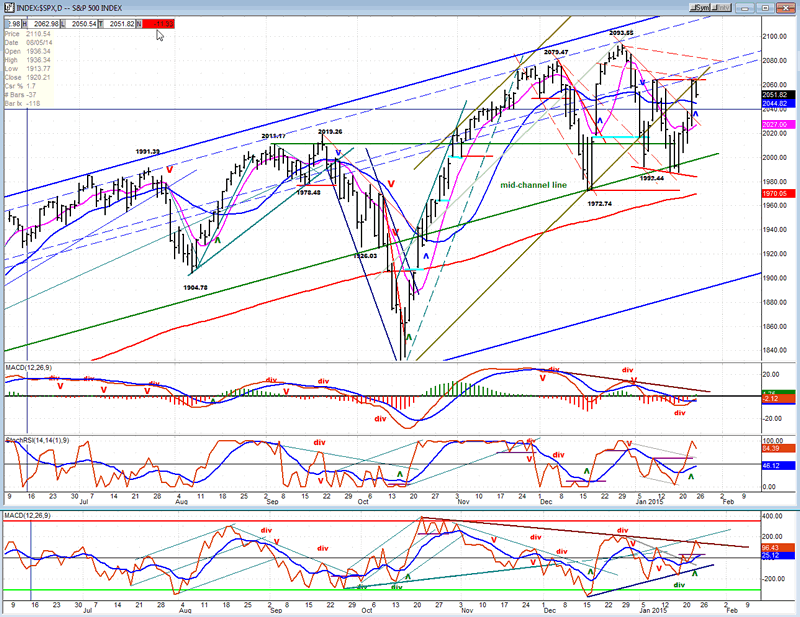
The failed attempts by the last two rallies at regaining the upside momentum (I am making a premature assumption that last week's rally has also failed) could have been anticipated by the weakness showing in the MACD and the A/D oscillators, both of which have been in a downtrend for several weeks. If the lower oscillator breaks its short uptrend line, I will probably signal that the index is ready to break below the mid-channel line. Of course, if the downtrend lines of both oscillaors are penetrated, it will be an indication that more short term strength will be seen.
The hourly chart holds the key to my expectation for lower prices next week. All three oscillators are now in a downtrend which looks like it is just starting. Friday's retracement has already taken the index close to its uptrend line and, with the oscillators in this condition, it's almost a cinch to break it. A move below the 200-hr MA (red) could lead, initially, to a back-test of the red downtrend line.
With the weekly indicators still in a decline and the daily in a questionable position, the correction of the hourly oscillators could bring about a fair amount of weakness, especially since enough distribution occurred at Friday's top to project the index to a lower level.
On this chart, it will take a break of the mid-channel line to start a potential decline to the bottom of the intermediate channel.
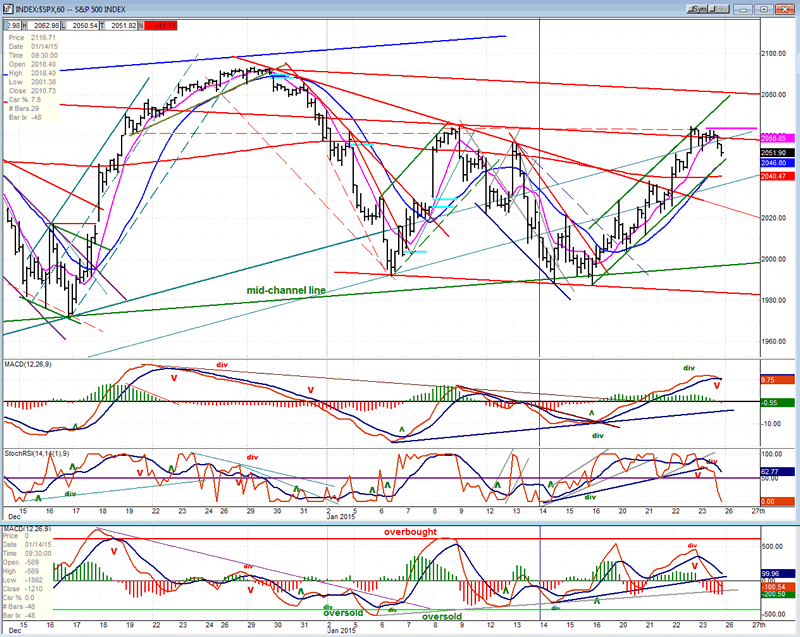
XIV (Inverse NYSE Volatility Index) - Leads and confirms market reversals.
XIV has reached the lower trend line of its long-term up channel which intersects with an inner trend line of its intermediate down channel. This has created enough support for the index to have a bounce -- which is what happened last week -- but it has not affected its relationship to SPX which remains relatively weak.
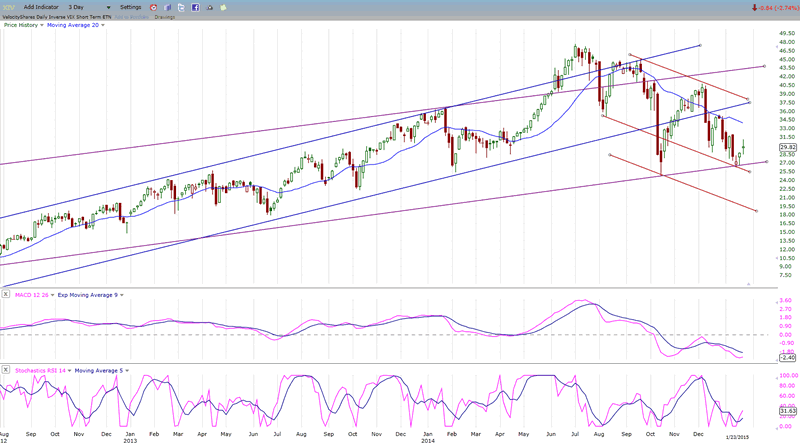
XLF (Financial Sector SPDR) - Historically a market leader.
XLF took advantage of the market rally to bounce back to its broken support and trend line, but it was quick to retrace with Friday's pull-back and remains in a short term downtrend.
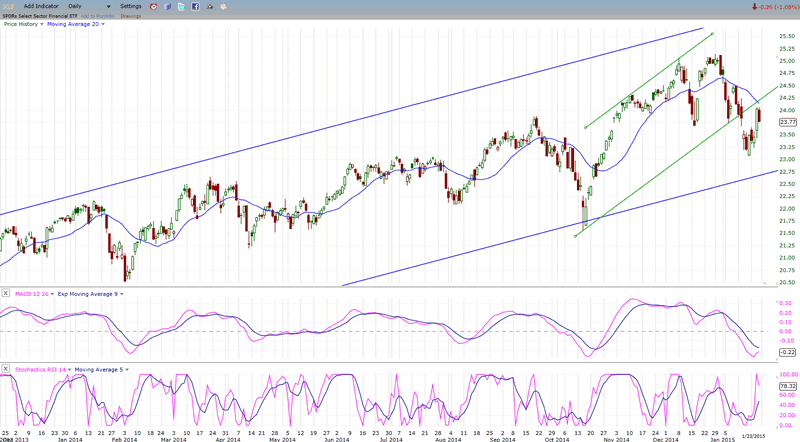
XBD (American securities Broker/Dealer)
XBD recently re-tested its intermediate trend line (green) and the mid-channel line of its long-term channel. The last time this support was tested, it provided a strong rally; this time, only a weak re-bound, so far!

UUP (dollar ETF)
Spurred on by the Euro's weakness, last week UUP catapulted to the top of its long-term channel where it could find some resistance and consolidate its move (but only if the buying spree on which it has been can be harnessed -- a least temporarily).
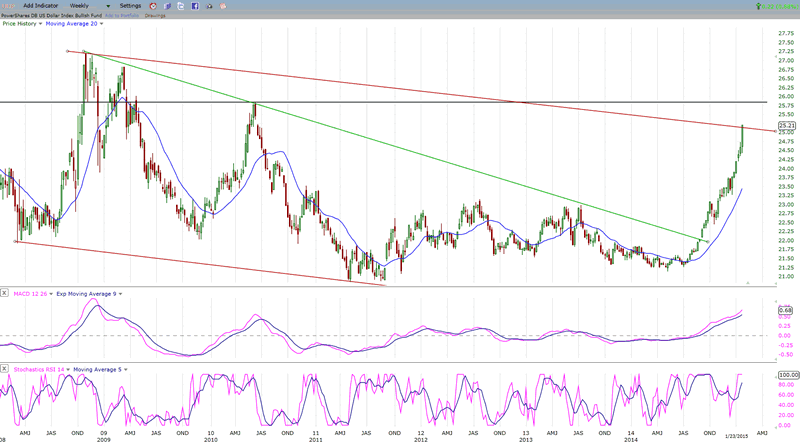
GLD (Gold trust)
Gold has rallied to its mid-channel line where it has found resistance on past occasions. Since 125 fills an initial phase count from its base, it may digest its gains for a little while before moving on to the entire base count of 131.

USO (US Oil Fund)
USO continues to aim for the bottom of its long-term channel. Whether it pauses first or moves directly down to it is probably only a matter of time.
Summary
SPX found enough resistance at its previous short-term high of 2064 to put a halt to the strong rally which started at 1988. Friday's retracement does not look complete and it's now a question of whether the bears will be able to muster enough strength to regain the downside momentum. Next week will be key in determining the market's short term direction and preventing the January barometer from being bearish.
FREE TRIAL SUBSCRIPTON
If precision in market timing for all time framesis something that you find important, you should
Consider taking a trial subscription to my service. It is free, and you will have four weeks to evaluate its worth. It embodies many years of research with the eventual goal of understanding as perfectly as possible how the market functions. I believe that I have achieved this goal.
For a FREE 4-week trial, Send an email to: ajg@cybertrails.com
For further subscription options, payment plans, and for important general information, I encourage
you to visit my website at www.marketurningpoints.com. It contains summaries of my background, my
investment and trading strategies, and my unique method of intra-day communication with
subscribers. I have also started an archive of former newsletters so that you can not only evaluate past performance, but also be aware of the increasing accuracy of forecasts.
Disclaimer - The above comments about the financial markets are based purely on what I consider to be sound technical analysis principles uncompromised by fundamental considerations. They represent my own opinion and are not meant to be construed as trading or investment advice, but are offered as an analytical point of view which might be of interest to those who follow stock market cycles and technical analysis.
Andre Gratian Archive |
© 2005-2022 http://www.MarketOracle.co.uk - The Market Oracle is a FREE Daily Financial Markets Analysis & Forecasting online publication.



